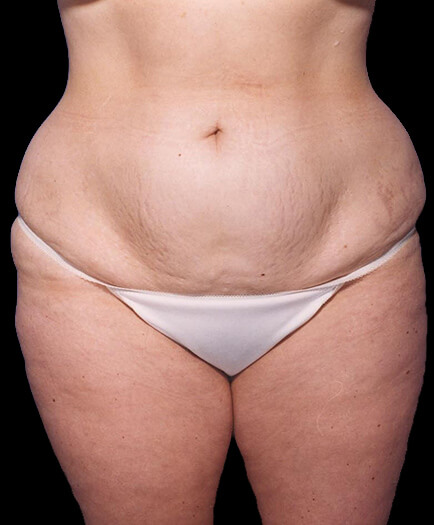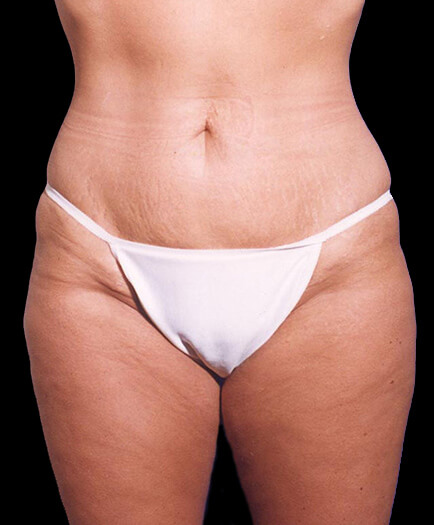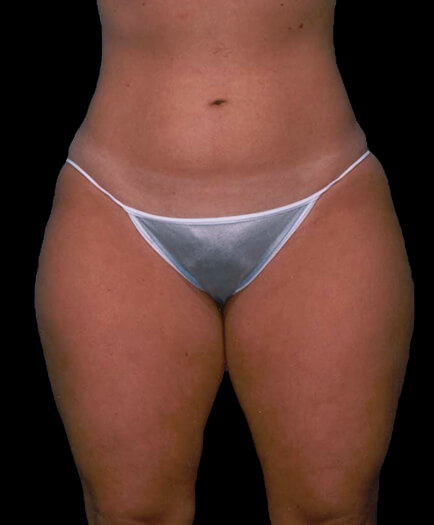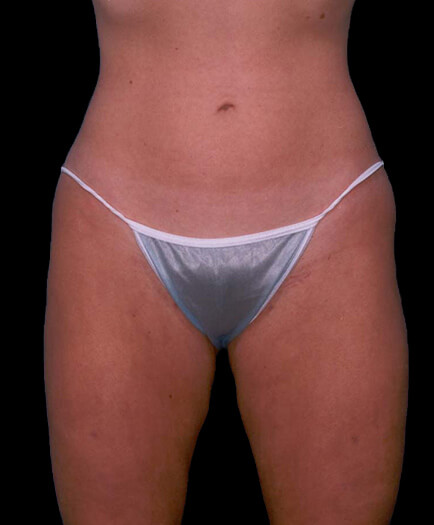We live in an era where exercise and weight control are very popular. However, despite exercise and diet, many people suffer from excess weight or localized accumulations of fat. Some find this weight difficult to lose. Such accumulations of fat can be removed with the use of a high vacuum device. The objective of liposuction is to contour the body to give it the best possible form with the least amount of remaining fat. Liposuction is one of the most popular plastic surgery procedures performed by Dr. Marefat. With offices located in the Arlington area and Woodbridge, Virginia, Dr. Marefat offers a variety of body sculpting procedures to reshape your body.
The popularity of liposuction is perhaps due to its relative simplicity (in the hands of a qualified surgeon). Large amounts of fat can safely be removed through incisions that are barely visible. The fat suctioned never comes back. However, you must remember that it is impossible to suction all fat cells, and the ones that remain may get enlarged if you do not control your dietary intake.
In recent years, modern methods of liposuction have virtually eliminated all its dangers. The technique of tumescent liposuction has made it possible for the surgeon to remove large amounts of fat without the need for a blood transfusion, which was necessary in many large suctioning procedures in the past. There is also much less discomfort and a shorter recovery time with this technique. Through liposculpture, the surgeon can artistically shape targeted areas of the body to the ideal form. Liposculpture is more time-consuming and requires greater artistic sensibility than regular liposuction. Power-assisted liposuction (PAL) and ultrasonic liposuction use technologically advanced methods to achieve faster or more thorough evacuation of fat. However, their use does not guarantee a better result.
Technological advances are being made in other areas that are now challenging traditional liposuction as the most efficient method of fat reduction. The use of laser technology in liposuction (smartLipo®) is still in its preliminary stages and its advantage over more conventional techniques is yet to be proven. Mesotherapy and lipodissolve are techniques that use injectable agents to dissolve fat. These methods are gaining popularity through the media; however, in the professional community, there is some skepticism for the use of these solutions in large volume fat reduction. Until the safety and efficacy of these methods is established beyond any doubt, it is safer to use traditional techniques of fat removal.
The liposuction procedure can be done under local anesthesia plus sedation or under general anesthesia, depending on the extent of surgery. The vacuum suction is inserted in the fatty layer of skin through a small incision, and fat is removed. Depending on the extent of fat removal, you may be able to have liposuction done in our Virginia office. Dr. Marefat has minor procedure rooms in his offices in northern Virginia where he can address small pockets of fat accumulation using local anesthesia. However, in cases with larger volumes of fat, he usually likes to use an outpatient facility, such as Inova Springfield Surgery Center in Alexandria, Alexandria Hospital, or the Virginia Hospital Center.
It is important to understand that Virginia liposuction is not a substitute for proper diet and exercise. The best liposuction candidates are those who have localized accumulations of fat. The elastic property and tone of skin are also important in achieving good results. If you have skin of poor elasticity, Dr. Marefat may recommend a skin tightening procedure in conjunction with Virginia liposuction. Although skin removal is effective in eliminating excessive laxity, it does leave permanent scars.
After liposuction surgery in Virginia, you will wear a compression garment in order to minimize the swelling in the suctioned areas. Wearing this garment for 4 weeks ensures proper healing and recovery.
Depending on the extent of liposuction surgery, you may be able to resume normal activities the same day, or you may need a week to recover. Generally, recovery is complete no matter how extensive the procedure by the end of the first week. Rigorous and strenuous activities should be avoided in the first few weeks.
Many people who are contemplating liposuction have heard about the tumescent technique. This technique involves injecting large amounts of saline solution mixed with various medications in the area that is to be suctioned. The medicine that is placed in the solution is actually the same medication used for local anesthesia. In addition to this local numbing medication, the surgeon places a small amount of epinephrine in each bag of tumescent solution. These medications are then infused in this diluted solution into the area of suctioning. As a result, the patient can have large volumes of fat removed without experiencing significant pain or blood loss. The relationship between the amount of tumescent solution used and the amount of liposuctioning performed varies, but is usually between a 2:1 or 1:1 ratio. As a result of this technique, a lot more fat can be removed from the patient without the risk of hemorrhage. Another advantage of this technique is it usually requires less intra-operative and postoperative pain medication. An individual may be able to have the procedure done under strict local anesthesia (e.g., tumescent solution only), provided that the amount of fat removal is not excessive and the surface area of the body treated is small.
Lipoplasty or suction lipectomy (liposuction) is one the most frequently performed procedures in cosmetic surgery in many countries around the world. Although this procedure is very safe, there are still serious risks that may attend it. For example, the death rate as a result of liposuction is about 1/5,000.
It must be remembered that liposuction is performed by many health care practitioners who are not trained in plastic surgery. Dermatologists, internists, gynecologists, oral surgeons, otolaryngologists, and even some dentists have been known to perform liposuction. Liposuction should be performed in a facility that has the equipment and personnel to deal with life-threatening situations.
The American Society of Aesthetic Plastic Surgery created a task force for establishing the risks of liposuction. Among the risk factors that are known for liposuction, they named the following as most important:
In the past several years, the American Society of Plastic Surgeons has recommended a maximum of 5,000cc of fat removal in one day. Since this rule has been established, the number of deaths as a result of liposuction performed by board certified plastic surgeons has dramatically decreased.
Obviously, prevention of problems is the best way to avoid complications. The most important factors that come into the equation of safe liposuction are:
Liposuction is a procedure designed to remove unwanted fat with minimal incisions.
The ideal candidate for liposuction is a person who has fat accumulation in an area disproportionate to the remainder of the body. When dieting and exercising is unable to get rid of this extra fat, liposuction can be used to shape and contour this area to suit the rest of the body. Patients should have reasonable expectations about the results they will achieve with this surgery. They should also be in good health and have a moderate degree of skin elasticity.
Generally, patients with widespread obesity or excessive, loose skin are not helped by liposuction. For many patients who have excessive skin or who have lost the elasticity of their skin, a traditional skin resection may be necessary. If their body contouring irregularities are due to structures other than fat, such as bone or weaknesses in the muscles, these problems cannot be corrected by liposuction. On occasion, it may be necessary to address these problems at a later date with other surgical procedures.
Liposuction can take away fat permanently. Each person is born with a specific number of fat cells. These fat cells get larger or smaller, depending on the amount of calories consumed or the metabolism of the person. When you remove the fat cells from an area of the body (e.g., the outer thigh), the fat never comes back. You will still have some fat cells remaining in that area, but, if the procedure is done correctly, you will have long-lasting effects.
Not usually. Cellulite is located in a more superficial layer and is not usually removed with liposuction. If the patient has cellulite, it is likely that the areas of cellulite will still be present after liposuction surgery and, on occasion, may become even more noticeable.
In the first consultation, you will have a chance to discuss your concerns with our patient care coordinators and Dr. Marefat. We will explain what you need to know about your Virginia liposuction procedure and help to determine what is best for you. You will receive information booklets and pricing on the procedure.
Liposuction is done through a small puncture hole that is usually hidden in a natural fold of the body. The incision itself can be as small as 1/8th of an inch. The area to be suctioned is then infiltrated with a solution containing medicines that reduce bleeding and postoperative pain; this is why large amounts of fat can be removed with little blood loss and no need for hospitalization.
Our objective is to improve body contours. However, we cannot change the nature of the skin. We want to establish more aesthetic proportions between the areas of the body and give the body a better overall harmony. We also want to improve the appearance both in and out of clothing.
It depends on how much treatment you need. Local anesthesia, IV sedation, or general anesthesia can all be used for Virginia liposuction. In all cases, however, the local injections of the tumescent solution are used whether or not you are asleep. With the tumescent technique, the amount of IV sedation or general anesthetic is decreased, resulting in lower risk of side effects as a result of these anesthetics. Some patients are very uncomfortable about being awake during the procedure, and, in such situations, it is best to be put under general anesthesia.
After surgery, you will have a moderate amount of drainage from the liposuction incisions. You will need to rest for the first 2-3 days, but most people are up and about shortly after Virginia liposuction surgery. We generally recommend our patients take 5-7 days off from work. Heavy lifting and exercising should be avoided for the first 2 weeks. Your body will tell you when you are ready to get back into your regular exercise routine. You will need to wear support garments for approximately 4-6 weeks after liposuction surgery. This helps the skin attach to the underlying tissues after liposuction and reduces the chance of fluid collection under the skin. During this interval, you can remove the garment to shower and rest your skin for short periods. There will be some numbness associated with the liposuction surgery. This numbness usually persists for about 4-6 weeks. Minor lumps and irregularities are common after Virginia liposuction. These irregularities are related to fluid accumulated in the subcutaneous fatty layer of the skin or the trauma associated with liposuction. Irregularities even out after the first 2-3 weeks post-surgery. Minor asymmetry between the two sides of the body can be seen after Virginia liposuction. This, too, is related to accumulations of fluid or trauma pertaining to the operation. These asymmetries usually resolve within 2-3 weeks after liposuction.
Not usually. However, this is still the most common aesthetic complication of liposuction. It seems to occur more in people with poor skin tone and patients who have cellulite. One way to avoid waviness and irregularities is for the doctor to use very small gauge cannulas and to take his time removing the fat. Even when everything is done right, there is still a chance that you may develop some irregularity. If this does occur, we can usually fix this problem in a touch-up procedure. This touch-up procedure is done approximately 3 months after the initial liposuction.
Before focusing on the complications of liposuction, it is important to consider how to digest these pieces of information. Reading about complications can be quite scary. Many people cannot comfortably sit through a consultation without having some real doubts about surgery. It is different when you have these complications explained to you by a doctor. Dr. Marefat can put them in perspective for you, and identify the likelihood of such complications occurring. Most complications are very rare. Some are less rare and need to be explained to you in more detail. This way, you can understand how we would tackle these problems if they occurred. We explain the risks and the complications so that you are aware of what steps we would take to treat you and put you back on the road to recovery. Remember that every surgeon has his or her own way of treating problems. You must go over these potential risks with your surgeon to gain better insight and understanding.
Touch-ups are performed after 3 months. These are much simpler than the original procedure and are not as painful. The doctor can usually perform them in our Virginia offices with a small amount of local anesthetic.
In general, there are very few sutures in liposuction procedures. These usually come out within the first week. You may be given absorbable sutures that do not need to come out.
We like to see our patients frequently after surgery. You are seen by the Doctor or nurse within 2-3 days of your surgery. The normal postoperative routine is 1 week, 1 month, 3 months, 6 months, and 12 months. Of course, if there is a need, you may be seen more often. After the first year, we encourage our patients to come in for routine follow-up visits every 3-5 years.
You should be able to wear makeup if you have had Virginia liposuction. However, we do not recommend putting makeup on your incisions. This may result in tattooing of the skin by the pigments in the makeup.
You are a good candidate for Virginia liposuction if your body contains localized areas of fat and if you have good skin tone, are healthy, and have realistic expectations. This does not mean that you cannot have Virginia liposuction if you do not meet these criteria. However, the best results are seen in individuals who cannot rid themselves of the fat that has collected in 1-2 areas of their body using diet and exercise. Generally, the younger you are, the better candidate you are for surgery. A person’s physiological age is more important than his or her chronological age. That is to say, you may be 60 years old, but your skin and general health may be better than that of most 50 year olds.
You can pay for Virginia liposuction surgery by certified check, credit card, or cash. Payment for cosmetic surgery is expected prior to any procedure. If you are scheduled for surgery several weeks in advance, you may pay by personal check.
Yes. However, these scars are very small (about 1/8th of an inch) and are usually hidden in areas that you would not normally see (e.g., belly button or pubic hair area). Each area of liposuction will generally have 1-2 small scars. After several months, these scars fade and are hardly visible.
The pain involved in liposuction is very tolerable. We have heard our patients describe it as muscle aches and pains or just soreness. Many patients do not finish the pain medications prescribed to them for pain relief. Having said that, remember that pain is very subjective, and it is not easy to predict what degree of pain you will have.
If you are just having a small area treated, which can be performed in the office, then you will be awake. However, if you are receiving liposuction in a larger area or are having multiple areas treated, you will most likely have the procedure performed in an outpatient facility while under general anesthesia.
The surgery can either be done in the office or the outpatient facility, depending on the size and number of areas receiving liposuction. For example, if you have small, localized areas of fat in your outer thighs, it is feasible to do this in the office under local anesthesia. On the other hand, if you want to receive liposuction across your entire midsection, then you are more likely to have the procedure in the outpatient facility. We rarely see the need to perform liposuction in a hospital setting anymore. Only in rare situations where the patient may have risk factors does Dr. Marefat suggest surgery in a hospital environment.
BEFORE

AFTER

BEFORE

AFTER

Yes. In all cosmetic and reconstructive cases, medical photos are taken. Photographs are mandatory. This is the only way for us to compare your status before the procedure to your results. Photographs in plastic surgery serve much the same role that x-rays serve for orthopedic surgery.
Dr. Marefat and the staff at Metropolitan Plastic Surgery would be happy to help you set up a private consultation to discuss liposuction / tumescent liposuction in Virginia. Schedule an appointment online or call one of our locations at 703-516-7600 (Arlington area) or at 703-560-9583 (Woodbridge).
Dr. Marefat offers a number of financial assistance programs and payment programs to cover the cost of liposuction / tumescent liposuction in Virginia. Please visit the patient financing section of our website for more details or ask the staff at Metropolitan Plastic Surgery about these options so that you can get started with liposuction / tumescent liposuction in Virginia today.